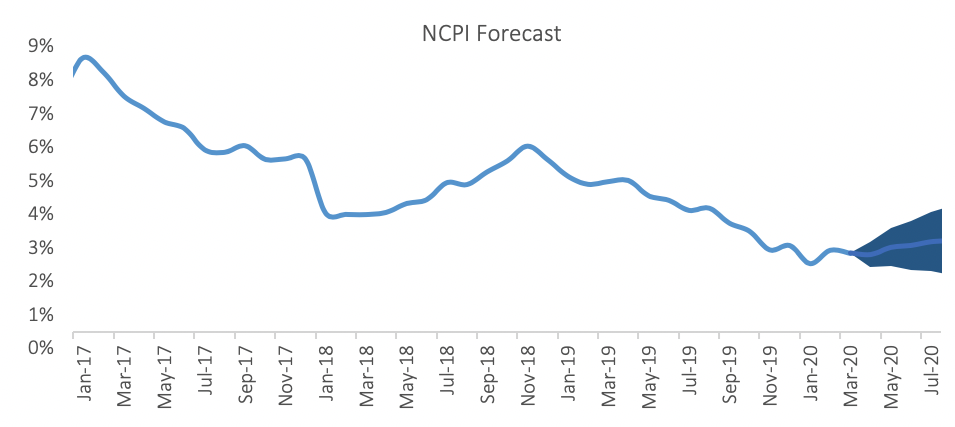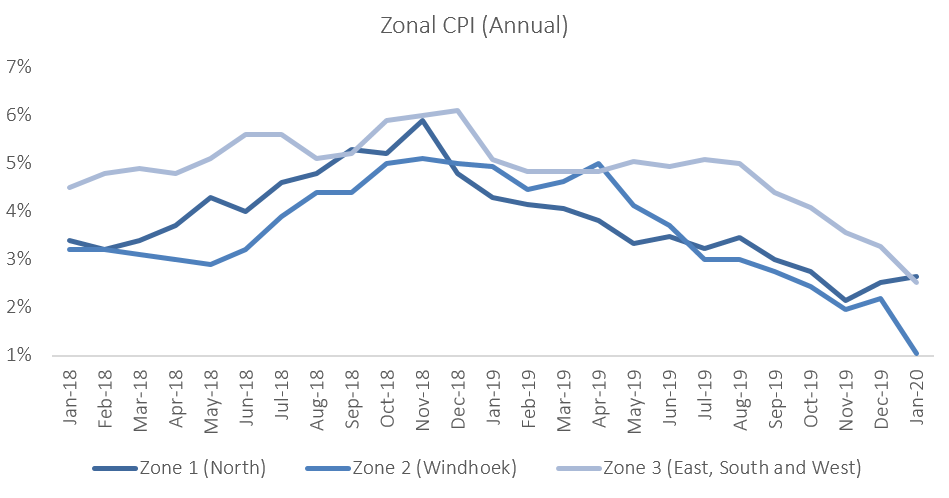
The Namibian annual inflation rate remained relatively unchanged at 2.4% y/y in March, following 2.5% y/y uptick in prices in February. Prices in the overall NCPI basket increased by 0.1% m/m, as inflationary pressures remain muted. On a year-on-year basis, overall prices in four of the twelve basket categories rose at a quicker rate in March, while six categories recorded slower rates of inflation and two categories posted steady inflation. Prices for goods increased by 3.3% y/y while prices for services increased by 1.0% y/y.

As in February, Transport was the largest contributor to annual inflation in March, accounting for 0.6 percentage points of the total 2.4% annual inflation rate. Transport prices fell by 0.3% m/m, but rose 4.4% y/y in March. The Ministry of Mines and Energy dropped the fuel pump price of diesel by 30 cents per litre in March, which resulted in a price drop of 0.5% m/m in the operation of personal transport equipment sub-category, and the annual increase to slow to 5.5% y/y in March from 5.9% y/y recorded in February. Given that a relatively large fuel pump price cut was announced for both petrol and diesel for April, inflationary pressure is likely to remain very low for this subcategory. Despite OPEC agreeing to cut oil production by 9.7 million barrels in May and June, oil prices are expected to remain low for the next few months as the demand for oil remains low, and oil producers are running out of storage space. The purchase of vehicles subcategory recorded price increases of 4.9% y/y, while the prices of public transport services remained steady.

Prices for the food & non-alcoholic beverages category was the second largest contributor to the annual inflation rate in March. Prices in this category rose by 0.1% m/m and 2.9% y/y. Prices in twelve of the thirteen subcategories recorded increases on an annual basis. The largest increases were observed in the prices of fruits which increased by 16.4% y/y and vegetables which increased by 8.3% y/y. The bread and cereals subcategory recorded price decreases of 0.9% m/m and 0.7% y/y.
The education basket recorded inflation of 7.6% y/y, with the cost of pre-primary education growing at a rate of 5.6% y/y. Primary and secondary education recorded price increases of a rather hefty 23.1% y/y, while tertiary education prices fell by 2.6% y/y. None of the three subcategories printed price increases on a month-on-month basis.

The NSA’s regional CPI data shows that on a monthly basis prices declined by 0.1% in the northern zone 1 while rising by 0.1% elsewhere in the country. On an annual basis the Windhoek and surrounding area, in zone 2, recorded the lowest inflation rate at 1.9% y/y in March, with the northern region recording the highest rate of annual inflation at 2.6% y/y. Inflation in zone 3 (Eastern, Southern and Western regions) remained unchanged at 2.5% y/y.

Namibian annual inflation remained muted in March at 2.4% compared to 2.5% in February. We expect this to remain the case for the rest of the year. Oil prices are expected to remain low for as long as factories across the world remain closed. The lockdown imposed by the Namibian government has put a number of businesses and consumers under severe financial pressure, which will result in consumers simply not being able to afford higher prices on goods and services. This will put further downward pressure on inflation as consumers will mostly direct their spending toward essential goods and services. IJG’s inflation model forecasts an average inflation rate of 2.6% y/y in 2020 and 4.3% y/y in 2021.













